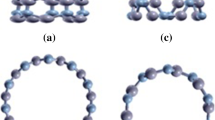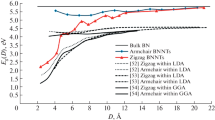Abstract
Electronic structure properties including bond lengths, bond angles, tip diameters, dipole moments, energies, band gaps, and nuclear magnetic resonance (NMR) and nuclear quadrupole resonance (NQR) parameters were calculated using density functional theory (DFT) for Si-doped boron phosphide nanotubes (BPNTs). Geometry optimizations were carried out at the B3LYP/6-31G* level of theory using the Gaussian 03 program suite. The chemical shielding parameters for the sites of various 29Si, 11B, and 31P atoms, and quadrupole coupling constants and asymmetry parameters at the sites of various 11B nuclei, were calculated for the Si-doped (6,0) zigzag BPNT models. The dipole moments and average B–P bond lengths of the Si-doped BPNT structures show slight changes between the Si-doped and pristine models. For the SiB model the diameter values are increased, whereas in the SiP model the changes of the diameter values are negligible. In comparison with the pristine model, the band gaps of the SiB and SiP models are reduced, whereas their electrical conductance is increased. Comparison of the NMR and NQR parameters calculated for the SiB and SiP models showed that the electronic structure properties of the SiB (6,0) zigzag BPNT model are more strongly influenced than those of the SiP model.
Graphical abstract



Similar content being viewed by others
References
Ijima S (1991) Nature 354:56
Derycke V, Martel R, Appenzeller J, Avouris P (2002) Appl Phys Lett 80:2773
Liu C, Fan YY, Liu M, Cong HT, Cheng HM, Dresselhaus MS (1999) Science 286:1127
Zurek B, Autschbach J (2004) J Am Chem Soc 126:13079
Nojeh A, Lakatos GW, Peng S, Cho K, Pease RFW (2003) Nano Lett 3:1187
Mirzaei M, Mirzaei M (2010) Monatsh Chem 141:491
Mirzaei M, Seif A, Hadipour NL (2008) Chem Phys Lett 461:246
Moradian R, Azadi S, Vasheghani Farahani S (2008) Phys Lett A 372:6935
Qian Z, Hou S, Zhang J, Li R, Shen Z, Zhao X, Xue Z (2005) Physica E 30:81
Mirzaei M, Giahi M (2010) Physica E 42:1667
Mirzaei M, Mirzaei M (2010) J Mol Struct (Theochem) 951:69
Wu Q, Hu Z, Liu C, Wang X, Chen Y (2005) J Phys Chem B 109:19719
Roy S, Springborg M (2009) J Phys Chem C 113:81
Zhang SL (2001) Phys Lett A 285:207
Mirzaei M (2009) Physica E 41:883
Mirzaei M (2009) Z Phys Chem 223:815
Bovey FA (1988) Nuclear magnetic resonance spectroscopy. Academic, San Diego
Baei MT, Moradi AV, Moghimi M, Torabi P (2011) J Comput Chem. 967:179–184. doi:10.1016/j.comptc.2011.04.015
Hou S, Shen Z, Zhang J, Zhao X, Xue Z (2004) Chem Phys Lett 393:179
Bengu E, Marks LD (2001) Phys Rev Lett 86:2385
Mirzaei M, Hadipour NL (2006) J Phys Chem A 110:4833
Mothana B, Ban F, Boyd RJ (2005) Chem Phys Lett 401:7
Drago RS (1992) Physical Methods for Chemists, 2nd ed. Saunders College Publishing, Florida
Pyykkö P (2001) Mol Phys 99:1617
Frisch MJ, Trucks GW, Schlegel HB, Scuseria GE, Robb MA, Cheeseman JR, Zakrzewski VG, Montgomery JA Jr, Stratmann RE, Burant JC, Dapprich S, Millam JM, Daniels AD, Kudin KN, Strain MC, Farkas O, Tomasi J, Barone V, Cossi M, Cammi R, Mennucci B, Pomelli C, Adamo C, Clifford S, Ochterski J, Petersson GA, Ayala PY, Cui Q, Morokuma K, Malick DK, Rabuck AD, Raghavachari K, Foresman JB, Cioslowski J, Ortiz JV, Baboul AG, Stefanov BB, Liu G, Liashenko A, Piskorz P, Komaromi I, Gomperts R, Martin RL, Fox DJ, Keith T, Al-Laham MA, Peng CY, Nanayakkara A, Gonzalez C, Challacombe M, Gill PMW, Johnson B, Chen W, Wong MW, Andres JL, Gonzalez C, Head-Gordon M, Replogle ES, Pople JA (2003) Gaussian 03, revision B03. Gaussian Inc., Pittsburgh
Author information
Authors and Affiliations
Corresponding author
Rights and permissions
About this article
Cite this article
Baei, M.T., Moradi, A.V., Torabi, P. et al. NMR and NQR parameters of Si-doped (6,0) zigzag single-walled boron phosphide nanotubes: a density functional study. Monatsh Chem 142, 1097–1104 (2011). https://doi.org/10.1007/s00706-011-0547-x
Received:
Accepted:
Published:
Issue Date:
DOI: https://doi.org/10.1007/s00706-011-0547-x




